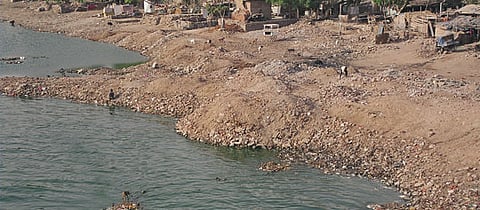Gujarat rivers remain highly polluted despite norms
The unchecked flow of untreated industrial effluent into rivers in Gujarat has led to increasing pollution in the Sabarmati, Mahisagar, Narmada, Vishwamitri and Bhadar. According to data from the Ministry of Environment and Forest (MoEF), the Sabarmati is among the most polluted rivers in the country.
Gujarat ranks fourth among the top five States with highly polluted rivers, with as many as 20 rivers in the critically polluted category.
Recently, a thick froth on the Mahisagar, along a stretch of several kilometres, raised serious concern, prompting the Gujarat Pollution Control Board (GPCB) to constitute a high-level committee to study the rising level of pollution in the river.
“Pollution in rivers has emerged as a major threat in the last few years because the lackadaisical approach of the authorities has emboldened the industries to discharge untreated effluents into flowing rivers,” said Vadodara-based environmental activist Rohit Prajapati.
He said that both treated and untreated effluent is released into the estuary of the Mahisagar and Gulf of Cambay, flouting the guidelines of the Central Pollution Control Board (CPCB).
As per the official parameters, if the chemical oxygen demand (COD), which indicates organic pollutant load, is higher than 250 mg per litre, then it should not be released into the rivers.
“Most of the Gujarat rivers where the effluents are dumped into, the COD level is in the range of 700 to 1000 mg per litre. While Dissolved Oxygen (DO) level [indicating the health of a river] in perennial rivers like Mahisgar should be in the range of 6 to 8 mg per litre, it is actually below 2.9 mg per litre,” he added.
In December 2020, Mr. Prajapati and a few others wrote a letter to the State authorities providing evidence, including videos and photographs, of how toxic effluents were being dumped into the Mahisagar and other rivers by industries.
“The Vadodara Enviro Channel Ltd, which runs a 55-km-long pipeline to discharge treated effluents into the deep sea, releases the effluents into the river. The effluents are not getting discharged into the deep sea as required,” a former official of the Gujarat Pollution Control Board told The Hindu.
Now, the State government has proposed a ₹2,300 crore project for a deep sea effluent disposal pipeline to cater to nearly 4,500 industrial units. The project will serve four highly industrialised districts (Ahmedabad, Vadodara, Kheda and Rajkot), which are the main sources of pollution of the rivers Sabarmati, the Mahisagar, the Vishvamitri and Bhadar.
The Centre had allocated almost ₹200 crore to curb pollution in the Sabarmati from 2014-15 to 2017-18 but the situation has only worsened.
Disclaimer: This story has not been edited by Water Today staff and is generated from news feeds. Source: The Hindu

